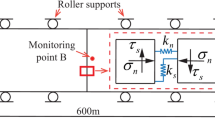Abstract
In the study of solute transport in rough single fracture, the contact area is an important factor. The single fracture is defined as two categories in this article: the full transfixion single fracture and the partial transfixion single fracture. The purpose of this article is to research how the contact area affects the solute transport in partial transfixion single fracture. The contact area is generalized as square blocks with three sizes, and contact rate is variable, a series of experiments for solute transport were conducted in a simulation model which can simulate the two types of fractures in the laboratory. Based on the analysis of the breakthrough curves and the experiment phenomena, it is concluded that the difference of breakthrough curves of various contact rates is evident and increases with the increase of contact rate, the relative error curves reflect the difference of block sizes, and the maximum errors increase from smaller than 0.2 to about 0.8 with the increase of contact rate. These phenomena are also explained qualitatively in this article. It is concluded that the contact area strongly affects solute transport, and the research of channels formed by contact area is useful to further understand the rule of solute transport in partial transfixion single fracture.
Similar content being viewed by others
References
ZHOU Zhi-fang, WANG Jin-guo and HUANG Yong. Theory on dynamics of fluids in fractured medium[M]. Beijing: Higher Education Press, 2007(in Chinese).
TSANG Y. W., TSANG C. F. Channel model of flow through fractured media[J]. Water Resources Research, 1987, 23(3): 467–479.
URSINO N., GIMMI T. and FLÜHLER H. Combined effects of heterogeneity, anisotropy, and saturation on steady state flow and transport: A laboratory sand tank experiment[J]. Water Resources Research, 2001, 37(2): 201–208.
JOSE S. C., RAHMAN M. A. and CIRPKA O. A. Large-scale sandbox experiment on longitudinal effective dispersion in heterogeneous porous media[J]. Water Resources Research, 2004, 40(12): W12415.
BERKOWITZ B., CORTIS A. and DROR I. Laboratory experiments on dispersive transport across interfaces: The role of flow direction[J]. Water Resources Research, 2009, 45(2): W02201.
BODIN L., DELAY F. and De MARSILY G. Solute transport in a single fracture with negligible matrix permeability: 1. Fundamental mechanisms[J]. Hydrogeology Journal, 2003, 11(4): 418–433.
NERETNIEKS I. Channeling with diffusion into stagnant water and into a matrix in series[J]. Water Resources Research, 2006, 42(11): W11418.
ODEN M., NIEMI A. and TSANG C. F. et al. Regional channelized transport in fractured media with matrix diffusion and linear sorption[J]. Water Resources Research, 2008, 44(2): W02421.
DU Rui, SHI Bao-chang. Incompressible multi-relaxation-time lattice Boltzmann model in 3-D space[J]. Journal of Hydrodynamics, 2010, 22(6): 782–787.
TAN Ye-fei, ZHOU Zhi-fang. Solute transport in natural fractures based on digital image technology[J]. Journal of Hydrodynamics, 2009, 21(2): 219–227.
ZHU Xue-yu, LIU Jian-li. Numerical study of contaminants transport in fracture-karst water in Dawu well field, Zibo City, Shandong Province[J]. Earth Science Frontiers, 2001, 8(1): 171–178(in Chinese).
YASUHARA H., ELSWORTH D. A numerical model simulating reactive transport and evolution of fracture permeability[J]. International Journal for Numerical and Analytical Methods in Geomechanics, 2003, 30(10): 1039–1062.
LIN Lin, YANG Jin-zhong, ZHANG Bin et al. A simplified numerical model of 3-D groundwater and solute transport at large scale area[J]. Journal of Hydrodynamics, 2010, 22(3): 319–328.
HUANG Yong, ZHOU Zhi-fang and YU Zhong-bo. Simulation of solute transport using a coupling model based on finite volume method in fractured rocks[J]. Journal of Hydrodynamics, 2010, 22(1): 129–136.
TSANG Chin-Fu, Modeling groundwater flow and mass transport in heterogeneous media: Issues and challenges[J]. Earth Science-Journal of China University of Geosciences, 2000, 25(5): 443–450.
WU Yan-qing. Dynamics of contaminant migration in porous medium[M]. Shanghai: Shanghai Jiaotong University Press, 2007(in Chinese).
Author information
Authors and Affiliations
Corresponding author
Additional information
Project supported by the National Natural Science Foundation of China (Grant Nos. 51079043, 41172204), the Research Innovation Program for College Graduates of Jiangsu Province (Grant No. CXZZ11_0450).
Biography: CAI Jin-long (1982-), Male, Ph. D. Candidate
Rights and permissions
About this article
Cite this article
Cai, Jl., Zhou, Zf. & Huang, Y. Laboratory Experiments on Solute Transport in a Partial Transfixion Single Fracture. J Hydrodyn 23, 570–579 (2011). https://doi.org/10.1016/S1001-6058(10)60151-5
Received:
Revised:
Published:
Issue Date:
DOI: https://doi.org/10.1016/S1001-6058(10)60151-5




